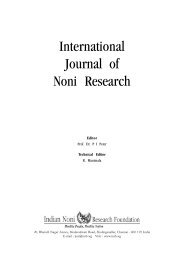International Journal of Noni Research - Noni Family
International Journal of Noni Research - Noni Family
International Journal of Noni Research - Noni Family
Create successful ePaper yourself
Turn your PDF publications into a flip-book with our unique Google optimized e-Paper software.
11 Intl. J. <strong>Noni</strong> Res. 2007, 2(1-2)<br />
P. Rethinam et al. <strong>Noni</strong> (Morinda citrifolia L.) - the Miracle Fruit - a holistic review<br />
medium.(Antony Selvaraj et .al., 2006). Further studies showed that the<br />
rooted plants have established well with 95-98.5% survival at green house<br />
conditions while hardening. Further better growth with zero per cent mortality<br />
was observed at nursery stage (Subramani et. al., 2006). Now micro<br />
propagated plants have gone for field test. Presently cell culture study is<br />
being carried out (Subramani et. al., 2007).<br />
Plant protection<br />
<strong>Noni</strong> growing in natural ecosystem did not have much pest problems, but<br />
became susceptible to a wide spectrum <strong>of</strong> insect pests, pathogens and<br />
nematodes when domesticated in a monoculture as experienced in Hawaii<br />
and other Pacific Island. Further, <strong>Noni</strong> is likely to become more and more<br />
susceptible when the cultivation is intensified to a larger extent. Literature<br />
revealed that Morinda citrifolia is infected by a wide range <strong>of</strong> fungal pathogens<br />
such as Phytopthora sp. and Sclerotium rolfisii (black flag and stem, leaf and<br />
fruit blights), Guignardia morindae, (leaf spot), Phellinus noxius (brown root<br />
rot) and Collectrotrichum sp. (anthraconose). A pathogenic alga, Cephaleuros<br />
minimus has been reported to cause leaf spot in <strong>Noni</strong>. Further, occurrence<br />
<strong>of</strong> mold infection caused by Rhizopus sp. in the post harvested fruits were<br />
recorded. <strong>Noni</strong> is susceptible to several species <strong>of</strong> root-knot nematodes, like<br />
Meloidogyne spp. and is also vulnerable to parasitic plants namely Cuscuta<br />
spp. and Cassytha filiformis. <strong>Noni</strong> is attacked by several insects, such as<br />
aphids (Aphis gossipii), scales (Coccus viridis), weevils, leaf miners, whiteflies<br />
(Dialuerdes kirkaldyi), caterpillars (Achaea janata), thrips (Heliothrips<br />
haemorroidalis) and unidentified eriophid mites. Excess use <strong>of</strong> nitrogenous<br />
fertilizers in <strong>Noni</strong> cultivation can induce susceptibitily to sap-feeding insects<br />
such as aphids, whiteflies and scales (Mathivanan, 2007). He also had<br />
suggested that systematic bio control studies should be initiated in the angle<br />
utilizing the knowledge on the use <strong>of</strong> natural enemies, microbial agents, and<br />
botanicals for control <strong>of</strong> various pests on <strong>Noni</strong>. How ever, there is scope for<br />
enhancing the impact potential <strong>of</strong> bio pesticides through improved formulations<br />
and application methods (Sithanantham, 2007).<br />
Marimuthu and Nakkeeran (2007) have suggested the use <strong>of</strong> plant growth<br />
promoting rhizobactera (PGPR) viz., Pseudomonos, Azospirillum, Rhizobium,<br />
Bacillus and Serratia spp. in the management <strong>of</strong> pests and diseases <strong>of</strong> noni.<br />
Nutrient deficiencies and disorders<br />
<strong>Noni</strong> is reported to display abnormal foliar symptoms for nitrogen, iron, and<br />
phosphorous deficiencies. Inter veinal chlorosis, scorching <strong>of</strong> leaf margins,








